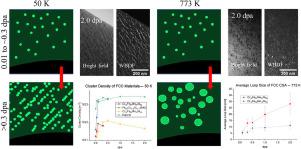当前位置:
X-MOL 学术
›
Acta Mater.
›
论文详情
Our official English website, www.x-mol.net, welcomes your
feedback! (Note: you will need to create a separate account there.)
In situ microstructural evolution in face-centered and body-centered cubic complex concentrated solid-solution alloys under heavy ion irradiation
Acta Materialia ( IF 8.3 ) Pub Date : 2020-10-01 , DOI: 10.1016/j.actamat.2020.07.066 Calvin Parkin , Michael Moorehead , Mohamed Elbakhshwan , Jing Hu , Wei-Ying Chen , Meimei Li , Lingfeng He , Kumar Sridharan , Adrien Couet
Acta Materialia ( IF 8.3 ) Pub Date : 2020-10-01 , DOI: 10.1016/j.actamat.2020.07.066 Calvin Parkin , Michael Moorehead , Mohamed Elbakhshwan , Jing Hu , Wei-Ying Chen , Meimei Li , Lingfeng He , Kumar Sridharan , Adrien Couet

|
Abstract This study characterizes the microstructural evolution of single-phase complex concentrated solid-solution alloy (CSA) compositions under heavy ion irradiation with the goal of evaluating mechanisms for CSA radiation tolerance in advanced fission systems. Three such alloys, Cr18Fe27Mn27Ni28, Cr15Fe35Mn15Ni35, and equimolar NbTaTiV, along with reference materials (pure Ni and E90 for the CrFeMnNi family and pure V for NbTaTiV) were irradiated at 50 K and 773 K with 1 MeV Kr++ ions to various levels of displacements per atom (dpa) using in-situ transmission electron microscopy. Cryogenic irradiation resulted in small defect clusters and faulted dislocation loops as large as 12 nm in face-centered cubic (FCC) CSAs. With thermal diffusion suppressed at cryogenic temperatures, defect densities were lower in all CSAs than in their less compositionally complex reference materials indicating that point defect production is reduced during the displacement cascade stage. High temperature irradiation of the two FCC CSA resulted in the formation of interstitial dislocation loops which by 2 dpa grew to an average size of 27 nm in Cr18Fe27Mn27Ni28 and 10 nm in Cr15Fe35Mn15Ni35. This difference in loop growth kinetics was attributed to the difference in Mn-content due to its effect on the nucleation rate by increasing vacancy mobility or reducing the stacking-fault energy.
中文翻译:

重离子辐照下面心和体心立方复合浓固溶体合金的原位显微组织演变
摘要 本研究表征了重离子辐照下单相复合浓固溶体合金 (CSA) 成分的微观结构演变,目的是评估先进裂变系统中 CSA 辐射耐受性的机制。三种这样的合金,Cr18Fe27Mn27Ni28、Cr15Fe35Mn15Ni35 和等摩尔 NbTaTiV,以及参考材料(CrFeMnNi 系列的纯 Ni 和 E90 以及 NbTaTiV 的纯 V)在 50 K 和 773 K 下以 1 MeV 到各种 Kr++ 水平的离子位移进行辐照原子 (dpa) 使用原位透射电子显微镜。在面心立方 (FCC) CSA 中,低温辐照导致小缺陷簇和大至 12 nm 的断层位错环。在低温下抑制热扩散,所有 CSA 中的缺陷密度都低于其组成不太复杂的参考材料,这表明在置换级联阶段减少了点缺陷的产生。两种 FCC CSA 的高温辐照导致间隙位错环的形成,在 2 dpa 后,Cr18Fe27Mn27Ni28 中的平均尺寸增长为 27 nm,Cr15Fe35Mn15Ni35 中的平均尺寸为 10 nm。环生长动力学的这种差异归因于锰含量的差异,因为锰含量通过增加空位迁移率或降低堆垛层错能对成核速率产生影响。两种 FCC CSA 的高温辐照导致间隙位错环的形成,在 2 dpa 后,Cr18Fe27Mn27Ni28 中的平均尺寸增长为 27 nm,Cr15Fe35Mn15Ni35 中的平均尺寸为 10 nm。环生长动力学的这种差异归因于锰含量的差异,因为锰含量通过增加空位迁移率或降低堆垛层错能对成核速率产生影响。两种 FCC CSA 的高温辐照导致间隙位错环的形成,在 2 dpa 后,Cr18Fe27Mn27Ni28 中的平均尺寸增长为 27 nm,Cr15Fe35Mn15Ni35 中的平均尺寸为 10 nm。环生长动力学的这种差异归因于锰含量的差异,因为锰含量通过增加空位迁移率或降低堆垛层错能对成核速率产生影响。
更新日期:2020-10-01
中文翻译:

重离子辐照下面心和体心立方复合浓固溶体合金的原位显微组织演变
摘要 本研究表征了重离子辐照下单相复合浓固溶体合金 (CSA) 成分的微观结构演变,目的是评估先进裂变系统中 CSA 辐射耐受性的机制。三种这样的合金,Cr18Fe27Mn27Ni28、Cr15Fe35Mn15Ni35 和等摩尔 NbTaTiV,以及参考材料(CrFeMnNi 系列的纯 Ni 和 E90 以及 NbTaTiV 的纯 V)在 50 K 和 773 K 下以 1 MeV 到各种 Kr++ 水平的离子位移进行辐照原子 (dpa) 使用原位透射电子显微镜。在面心立方 (FCC) CSA 中,低温辐照导致小缺陷簇和大至 12 nm 的断层位错环。在低温下抑制热扩散,所有 CSA 中的缺陷密度都低于其组成不太复杂的参考材料,这表明在置换级联阶段减少了点缺陷的产生。两种 FCC CSA 的高温辐照导致间隙位错环的形成,在 2 dpa 后,Cr18Fe27Mn27Ni28 中的平均尺寸增长为 27 nm,Cr15Fe35Mn15Ni35 中的平均尺寸为 10 nm。环生长动力学的这种差异归因于锰含量的差异,因为锰含量通过增加空位迁移率或降低堆垛层错能对成核速率产生影响。两种 FCC CSA 的高温辐照导致间隙位错环的形成,在 2 dpa 后,Cr18Fe27Mn27Ni28 中的平均尺寸增长为 27 nm,Cr15Fe35Mn15Ni35 中的平均尺寸为 10 nm。环生长动力学的这种差异归因于锰含量的差异,因为锰含量通过增加空位迁移率或降低堆垛层错能对成核速率产生影响。两种 FCC CSA 的高温辐照导致间隙位错环的形成,在 2 dpa 后,Cr18Fe27Mn27Ni28 中的平均尺寸增长为 27 nm,Cr15Fe35Mn15Ni35 中的平均尺寸为 10 nm。环生长动力学的这种差异归因于锰含量的差异,因为锰含量通过增加空位迁移率或降低堆垛层错能对成核速率产生影响。











































 京公网安备 11010802027423号
京公网安备 11010802027423号